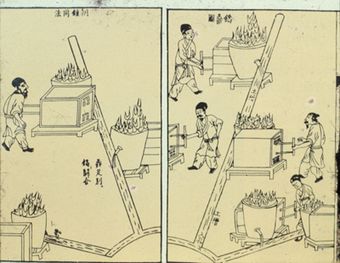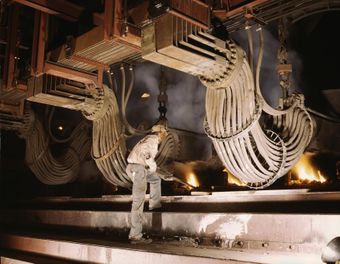صهر
الصـَهـْر Smelting هو صيغة من المتالورجيا الاستخلاصية؛ تـُستخدم أساساً في انتاج فلز من خامه. ويتضمن ذلك استخلاص الحديد (لانتاج الصلب) من خام الحديد، و استخلاص النحاس والفلزات القاعدية الأخرى من خاماتها. ويستعمل الصهر الحرارة وعامل اختزال كيميائي، غالباً ما يكون وقود يعمل كمصدر للكربون مثل فحم الكوك، أو في العصور القديمة charcoal, to change the oxidation state of the metal ore. The carbon or carbon monoxide derived from it removes oxygen from the ore to leave the metal. The carbon is thus oxidized, producing carbon dioxide and أول أكسيد الكربون. As most ores are impure, it is often necessary to use flux, such as الحجر الجيري، لإزالة the accompanying rock gangue as slag.
Plants for the electrolytic reduction of aluminium, while not using carbon, are also generally referred to as smelters.
. . . . . . . . . . . . . . . . . . . . . . . . . . . . . . . . . . . . . . . . . . . . . . . . . . . . . . . . . . . . . . . . . . . . . . . . . . . . . . . . . . . . . . . . . . . . . . . . . . . . . . . . . . . . . . . . . . . . . . . . . . . . . . . . . . . . . . . . . . . . . . . . . . . . . . . . . . . . . . . . . . . . . . . .
أساسيات الصهر
يمكن للفلزات السبع التي كانت معرفة في الأزمنة القديمة (الزئبق, القصدير, الرصاص, النحاس, الفضة, الذهب, والحديد)، من ناحية المبدأ، أن تـُصهـَر من خاماتها، من خلال تفاعلات كيميائية:
- أكسيد الزئبق إلى الزئبق
- Cassiterite to tin
- Minium to lead
- أكسيد الفضة إلى الفضة
- Cuprite to copper
- هماتيت إلى حديد
صهر البرونز

صهر الحديد
 مقالة مفصلة: تاريخ المتالورجيا الحديدية
مقالة مفصلة: تاريخ المتالورجيا الحديدية
صهر الحديد المبكر
أقدم دليل حتى الآن على صهر الحديد في bloomery يوجد في تل حمة، الأردن (see also external link), and dates to 930 BC (C14 dating). إلا أن، بناءً على السجلات الأثرية للأدوات الحديدية، يتضح أن الاختزال المتعمد لفلز الحديد من الخامات الأرضية (في حالة تل حمة كان خام هماتيت)، قد بدأ بالتأكيد بالقرب من نهاية العصر البرونزي المتأخر (ح. 1600-1150 ق.م.). Where and how iron smelting was discovered is widely debated, and remains uncertain due to the significant lack of production finds. Nevertheless, there is some consensus[بحاجة لمصدر] that iron technology originated in the Near East, ربما في شرق الأناضول.
وفي مصر القديمة، في وقت ما بين الفترة الوسيطة الثالثة والأسرة 23 (ح. 1100-750 ق.م.)، توجد مؤشرات على تشغيل الحديد. إلا أنه يجدر ذكر عدم وجود أدلة على صهر الحديد من الخام في مصر في أي فترة. ويوجد احتمال اضافي على صهر الحديد وتشغيله في غرب أفريقيا في 1200 ق.م.[1]. In addition, very early instances of صلب كربوني were found to be in production around 2000 years before the present in شمال غرب تنزانيا, based on complex preheating principles. These discoveries are significant for the history of metallurgy.[2]
Most early processes in Europe and Africa involved smelting iron ore in a bloomery, where the temperature is kept low enough so that the iron does not melt. This produces a spongy mass of iron called a bloom, which then has to be consolidated with a hammer.
صهر الحديد اللاحق
الفلزات القاعدية

طالع أيضاً
- فرن لافح
- Bloomery
- حديد زهر
- Clinker (waste)
- استخلاص النحاس
- فرن
- العصر الحديدي
- متالورجيا
- Pyrometallurgy
- Slag
- حديد مطاوع
- صهر الزنك
المصادر
- ^ How Old is the Iron Age in Sub-Saharan Africa? - by Roderick J. McIntosh, Archaeological Institute of America (1999)
- ^ Peter Schmidt, Donald H. Avery. Complex Iron Smelting and Prehistoric Culture in Tanzania, Science 22 September 1978: Vol. 201. no. 4361, pp. 1085 - 1089
- ^ Minet, Adolphe (1905). The Production of Aluminum and Its Industrial Use. Leonard
Waldo (translator, additions). New York, London: John Wiley and Sons, Chapman & Hall, via Google Books scan of University of Wisconsin - Madison copy. pp. 244 (Minet speaking) +116 (Héroult speaking). Retrieved 2007-10-28.
{{cite book}}: line feed character in|others=at position 8 (help)
ببليوجرافيا
- Pleiner, R. (2000) Iron in Archaeology. The European Bloomery Smelters, Praha, Archeologický Ústav Av Cr.
- Veldhuijzen, H.A. (2005) Technical Ceramics in Early Iron Smelting. The Role of Ceramics in the Early First Millennium Bc Iron Production at Tell Hammeh (Az-Zarqa), Jordan. In: Prudêncio, I.Dias, I. and Waerenborgh, J.C. (Eds.) Understanding People through Their Pottery; Proceedings of the 7th European Meeting on Ancient Ceramics (Emac '03). Lisboa, Instituto Português de Arqueologia (IPA).
- Veldhuijzen, H.A. and Rehren, Th. (2006) Iron Smelting Slag Formation at Tell Hammeh (Az-Zarqa), Jordan. In: Pérez-Arantegui, J. (Ed.) Proceedings of the 34th International Symposium on Archaeometry, Zaragoza, 3-7 May 2004. Zaragoza, Institución «Fernando el Católico» (C.S.I.C.) Excma. Diputación de Zaragoza.






